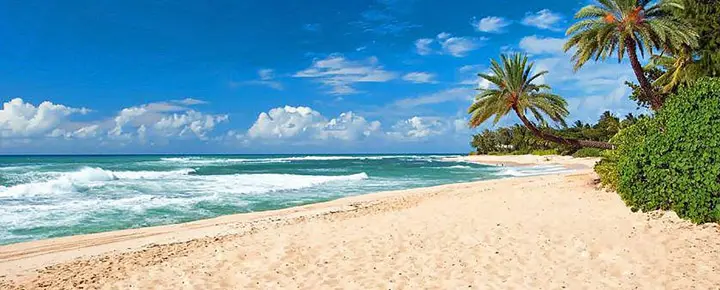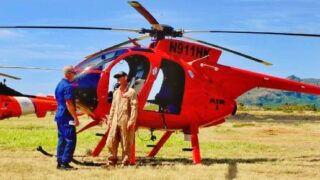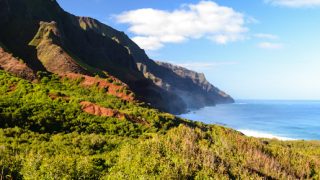Kauai’s beauty is part of what draws people here, but there can also be danger that can catch visitors off guard. The Kalalau Trail is one example. We’ve felt the heat, the super-slick ridges, and the weight of a pack that gets heavier by the mile.
Editor Jeff actually stood on Hanakapiai Beach and tragically saw someone drown. The ocean took them fast. It was silent in a way that didn’t feel natural, and that vision still hasn’t left him. If a moment encapsulates the risk many visitors don’t see coming, it’s that.
This isn’t about fear. It’s about how even seasoned hikers and swimmers are lulled by Hawaii’s unique and captivating beauty—especially here on Kauai—and how it’s leading to rescues and worse that could have been avoided.
Two rescues in one hour—and many more before that.
Last weekend, Kauai firefighters rescued two hikers less than an hour apart. One was on the Makaleha Falls Trail, who was struck by a falling rock and found unconscious at the base of the falls. The other was a visitor from Utah who injured her leg near mile 1.5 on the Kalalau Trail. Both were airlifted out.
These aren’t isolated events. Days earlier, when river levels suddenly surged, hikers were stranded on Makaleha and Kalalau. Rescue teams responded repeatedly, often under difficult conditions.
Both trails are rated hard, and Makaleha is unmarked primarily. It involves scrambling over boulders, is wet and muddy, has lots of mosquitoes, and is dangerous. Before attempting it, you must be in shape and experienced with this terrain.
In 2024, Kauai conducted more than 200 search and rescue missions, many involving visitors caught off guard by the terrain, flash floods, or poor planning.
Kauai isn’t alone.
Across Hawaii, rescues are rising. Other islands report similar patterns as visitors underestimate the state’s rugged terrain and rapidly shifting conditions. With no statewide rescue system, the responsibility falls to county fire departments, and volunteer SAR teams are already stretched thin.
Hawaii has debated letting counties seek reimbursement for rescues when visitors ignore posted warnings or enter closed areas. The idea has gained traction in legislative discussions, especially after costly helicopter operations and repeat incidents. But implementation is still in limbo, slowed by concerns over enforcement, liability, and tourism optics.
The myth of Hawaii’s “easy” hikes.
There’s a strange contradiction in how people perceive hiking in Hawaii. On the mainland, hikers prep for altitude, snow, and bears. There’s no frostbite or rattlesnakes here, so it must be okay, right?
Wrong.
Kauai’s terrain doesn’t play fair. Trails vanish into the jungle, ledges give out beneath ginger plants, flash floods strike without warning, and coastal cliffs crumble after a single rainstorm. The Kalalau Trail, often labeled “epic” or “bucket list,” has been called one of the most dangerous hikes in America for good reason.
But that doesn’t stop visitors from showing up underprepared, underdressed, or worse—fueled by Instagram fantasies and vacation brains.
Social media doesn’t just inspire—it distorts.
Photos of pristine beaches and daring cliffside hikes rarely come with warnings. When influencers post geotagged locations or show themselves on Instagram exploring closed or off-limits areas, they create a ripple effect that leads others into danger. Visitors follow phone apps to illegal trails. Some end up injured, stranded, or worse.
Rescue volunteers found phones next to victims, and camera apps were still open. One SAR leader on Oahu said it bluntly: “Instagram kills more people than coconuts.”
On Kauai, this plays out in places like Queen’s Bath, Larsen’s Beach, and Hanakapiai. Visitors seek out beauty, not realizing what they’re walking into. A trail that looks safe at noon can become treacherous by midafternoon. What looked like a gentle beach can become a death trap with one firm, unexpected wave.
When beauty turns deadly.
Hanakapiai Beach is one of the most stunning and remote spots on the island. The person Jeff saw drown didn’t look reckless. They likely thought a quick dip would be refreshing after the long hike. But there was no dramatic wave, no warning. Just the ocean turning—and they were gone.
That story repeats itself around Kauai.
Some beaches lack lifeguards or warning signs. Visitors head in, assuming beauty equals safety. They’re wrong.
As one reader wrote after nearly drowning at a popular beach: “I was within feet of others but couldn’t breathe. To them, I just looked like someone relaxing in the water.”
Even experienced swimmers say they’ve been caught off guard. The risks are rarely apparent unless you know the island’s ocean patterns in winter and summer; Sneaker waves. Rip currents. Hidden rocks. And no real-time guidance unless you actively seek it out.
The same false confidence that sends hikers out in flip-flops or across flooded rivers also leads people into the ocean, thinking, just a quick swim. Sometimes, it’s the last decision they ever make.
What needs to change—and what won’t?
No single fix will prevent all hiking and ocean-related injuries or deaths, but that doesn’t mean nothing can be done.
Hawaii tends to message safety with a soft touch. For trail risks, that may no longer be enough. More direct messaging—online, on signage, and in person—could make a difference.
Stricter limits during inclement weather, real-time warnings, and clearer guidelines on what “difficult” really means would help. So would a reminder that just because a trail is on Google Maps doesn’t mean it’s legal—or safe.
Still, much of this comes down to individual responsibility.
Our trail recommendations for average hikers.
Easy and primarily flat: Mahaulepu Trail at Poipu. Leave from Shipwrecks Beach and follow the ocean for 3 miles to Mahaulepu Beach. You can turn back at any point and still enjoy spectacular views.
We like two intermediate trails for those in good physical condition: Waipo‘o Falls Trail at Kokee and Sleeping Giant Trail in Kapaa. If it’s been raining, we would advise against Waipo’o Falls Trail. Both trails require appropriate footwear.
Kauai’s beauty is timeless, but your safety isn’t guaranteed. Turn back if you don’t feel comfortable or the hike is too challenging. Sometimes a short hike on our trails will be rewarding, like the first mile to Hanakapiai Beach.
The trails and beaches will still be there next year. Make sure you are, too. Please share your experiences. Mahalo!
Get Breaking Hawaii Travel News







So I was born and raised on the Big Island and although I no longer live in Hawaii, the āina is always a part of my soul. I am from North Kohala, and at the end of the road is Pololū Valley. I am encouraged to see that some of the local people have put together a group of stewards who volunteer their time to be at the top of valley, end of the road to educate and warn tourist and locals alike of the dangers and where they are allowed to hike and where to stay back. They also encourage those that do hike down to bring back a bit of trash to help preserve the beauty of the land. I know this may not be feasible is most areas but is a possible solution for some. They have Facebook page that they use to post warning about the tail conditions etc. and a website. ProtectPololu is the name of the group.
This is a case where strict enforcement rules could succeed if they were applied consistently, across the board, with real legal and financial ramifications for ignoring them. Charging people who ignore off limits and closed areas for the cost of rescue for example.
Another rule could be signs at trailheads detailing a required list of clothing and equipment to proceed. Would people ignore them? Of course, but it gives the state and local governments legal recourse to prosecute and recover the cost of rescues and damage to fragile sites…
Best Regards
Ae, a’ole.
How very bad, dangerous, hurt and sad.
Jesus, please watch over someone who’s been drowning from Hanakapiai beach.
And gods, please help and heel people to feel better, alive and good.
I think that any rescue on land or, at sea, should involve a fee. And notices at the entrance to trails should clearly state that this is the case. Web sites describing or promoting hikes and trails should also have to include the warning.
Makaleha was a favorite until last year when a bowling ball sized rock landed hard about 10 ft from me at the falls. I’ve had close calls at Kalalau and Hanakapi’ai but this was too big and close. Not recommended.
I did Sleeping Giant and it is indeed an intermediate hike but that’s assuming it’s dry and a comfortable temperature. Throw in some rain and high humidity, and you’d better be prepared with water and some good shoes.
My friend, who lives there in Kauai, watched his 300 pound cousin from New York drown in the washing machine like undertow at Polihale Beach…. This happened after many warnings from my friend who almost drowned trying to save him! You don’t hear much about it, but that is also a very dangerous place to swim.
I have hiked the 2 mile Kalalau Trail twice, most recently on my 50th birthday in 2023. Difficult but so beautiful! There are signs at the Hanakapai saying No Swimming – why do people
disregard?!?? I decided after the return hike where my husband had to hold my hand most of the way that I would do it again – just next time to the half mile lookout only and then the rest of the afternoon at Ke’e Beach!
Back in the 70’s, I hiked to Hanakapiai with my girlfriend and a local resident. I can’t believe we were actually drinking beer on the hike and once at the beach, I went to to cool off just to my knees and was immediately swept under. The local saved my life. It was very difficult for him to do. We got out and collapsed on the sand. I am only alive now to tell you because of the Good Lord above. This warning never gets obsolete. Don’t Swim there. It is Dangerous!!!
I tried to talk a group out of entering dangerous surf last month on the north shore. They literally laughed at me. Mminutes later, they were scrambling and started yelling for help. Thankfully someone reached them in time with a tube—but it was frightening.
If it is the same tubes as on Maui, a tip of the lei po’o to Rotary. I don’t know how many lives those tubes have saved, but all it takes is one, and I’m sure there’s many more than that.
There’s this illusion that everything in Hawaii is soft and slow. But the moment you’re out on a trail or near the ocean, you realize how fast things can turn. The beauty distracts you. That’s the trap.
We were at Queen’s Bath and saw three people climb down in sandals after rain. No gear, no clue. It’s not just dangerous—it’s exhausting to watch.
We were on the Kalalau Trail last year when a flash flood hit out of nowhere. It was terrifying. We barely made it out before dark. I’ll never take Hawaii’s conditions lightly again.
Warnings should be required reading at car rental counters on Kauai. Too many people hit the trail or beach with no clue what they’re stepping into.
What’s the difference between a Hawaii Rental Car and an SUV? There are some places the SUV can’t go! BadumpBump!!!
Sorry… But true…
I hiked the first 2 miles Hanakapiai Beach last year and because there had been little precipitation earlier the first, up hill portion was kind of muddy and slippery. When I was returning a couple hours latter it dawned on me that those rocky areas were not going to be any fun slipping on going down hill. Fortunately, it hadn’t rained or drizzled since late morning and the trail was dry by late afternoon. But if it hadn’t been???
Also, don’t wear shorts, tee shirts and flip flops to the top of 10,000+ foot mountains. The cold and wind can get you too.
I’ve hiked all over the world but nothing compares to the mental shift Kauai demands. One moment you’re in paradise, the next you’re calculating how to stay upright on a muddy ridge.